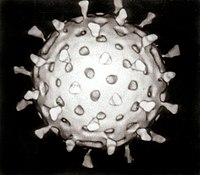
Photo from wikipedia
The prevalence of norovirus infections in different geographical locations and their attribution to childhood diarrhea is well established. However, there are no reports showing possible relationships of different norovirus genogroups… Click to show full abstract
The prevalence of norovirus infections in different geographical locations and their attribution to childhood diarrhea is well established. However, there are no reports showing possible relationships of different norovirus genogroups with subsequent childhood malnutrition. In this study, we attempted to establish a potential association between asymptomatic norovirus infections with childhood growth faltering during. Non-diarrheal stools were collected from 1715 children enrolled in locations in a multi-county birth cohort study across eight different geographical locations and were assessed for norovirus genogroup I (GI) and norovirus genogroup II (GII). Asymptomatic norovirus GI infections were negatively associated with monthly length-for-age Z score/LAZ (β = −0.53, 95% CI: −0.73, −0.50) and weight-for-age Z score/WAZ (β = −0.39, 95% CI: −0.49, −0.28), respectively. The burden of asymptomatic norovirus GI infections was negatively associated with LAZ (β = −0.46, 95% CI: −0.67, −0.41) and WAZ (β = −0.66, 95% CI: −0.86, −0.53) at 2 years of age, whilst the burden of asymptomatic norovirus GII infections was negatively associated with WAZ (β = −0.27, 95% CI: −0.45, −0.25) at 2 years of age. Our findings warrant acceleration in attempts to develop vaccines against norovirus GI and norovirus GII, with the aim of minimizing the long-term sequelae on childhood growth.
Journal Title: Viruses
Year Published: 2022
Link to full text (if available)
Share on Social Media: Sign Up to like & get
recommendations!